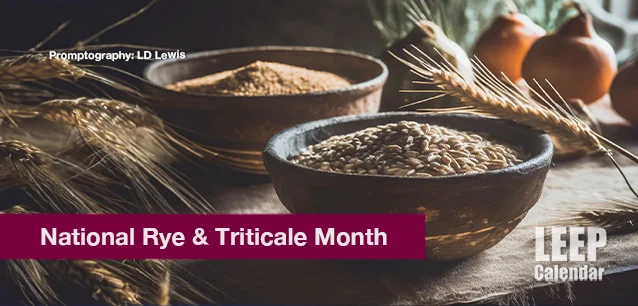 AD
AD
Today is: August 25
Scroll to explore events active on this date.
LEEP INK FEATURES

August? Absolutely!
In August, we live through the Dog Days of Summer. It's hot and often humid, and those who can leave for better climates do. Down south, winter is in full force. August is also known as "the ...

In The Heat of July: July 2025 Events
Is it hot enough (or cold enough if you're below the equator) for you yet? There is actually a day for that! Like every month, I pick a diverse collection of events you may or may not know about. This ...

May Blooms: Events in May 2025
Along with October, May is one of the most densely packed months of the year. It's before the summer humidity and the last whole month of the school year. The weather is warming in t...
About Rye and Triticale Month
Retail , United States
Ends: Aug 31, 2024
DESCRIPTION:
August is Rye and Triticale Month.
Rye and triticale, two grains with distinct origins and characteristics, have carved unique agriculture and culinary arts niches. Rye, with a history stretching back to ancient civilizations and triticale, a more modern invention, each tells a story of human innovation and adaptation in agriculture.
Rye, believed to have originated in southwestern Asia, has been cultivated since around 1800 BC. It likely started as a weed growing within wheat and barley fields, eventually being harvested and valued in its own right. By the Middle Ages, rye had become a staple grain in many parts of Europe, particularly in the colder northern regions where wheat struggled to thrive. Its hardiness in poor soils and colder climates made it crucial for societies in these areas.
Rye is usually associated with rye bread, including Germany's dense, dark pumpernickel bread. Its distinctive flavor, ranging from slightly sour to earthy, makes it a popular ingredient in crispbreads and other bakery products. Additionally, rye is a fundamental ingredient in the production of whiskey and some types of vodka, where its unique flavor profile is highly valued.
Conversely, triticale is a relatively new grain, first developed in the 19th century. It is a hybrid of wheat (Triticum) and rye (Secale), created to combine wheat's quality and yield with rye's hardiness. Triticale was not widely cultivated until agricultural advancements in the 20th century allowed for more successful hybridizations, leading to varieties with improved farming and baking qualities.
While triticale inherits the resilience to harsh conditions from rye, its wheat lineage contributes to a milder flavor and better bread-making qualities than pure rye. This fact makes triticale flour suitable for bread and pasta, often mixed with other flour. It's also used as animal feed and for producing alcoholic beverages, though to a lesser extent than its parent grains.
The histories of rye and triticale reflect different aspects of human agriculture. Rye's journey from a wild weed to a staple grain illustrates how societies adapt crops to suit their needs, particularly in challenging environments. Triticale, a product of intentional hybridization, showcases scientific advancement in agriculture, aiming to create crops that offer the best qualities of their parent species.
Despite their differences, rye and triticale remain essential in modern agriculture. Rye remains a crucial grain in many parts of the world, especially Europe. In contrast, triticale's growing popularity, particularly in parts of Canada, Europe, and Australia, highlights the ongoing innovation in crop development. Together, these grains exemplify the diversity and adaptability of crops in meeting human dietary and agricultural needs.
VIDEOS
SUPPORTING DOCUMENTS
Currently, this event does not have supporting documents.
ADDITIONAL IMAGES
Currently, this event does not have supporting images.
Where would you like to go now?
 AD
AD


/footer-logo.svg)
